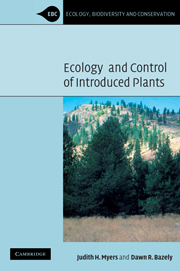Book contents
- Frontmatter
- Contents
- Preface
- 1 Introduction
- 2 Planet of Weeds: exotic plants in the landscape
- 3 Biological invasions in the context of plant communities
- 4 Predicting invasiveness from life history characteristics
- 5 Population ecology and introduced plants
- 6 Introduced plant diseases
- 7 Biological control of introduced plants
- 8 Modeling invasive plants and their control
- 9 Action against non-indigenous species
- 10 Genetically modified plants and final conclusions
- Appendix
- References
- Index
7 - Biological control of introduced plants
Published online by Cambridge University Press: 02 December 2009
- Frontmatter
- Contents
- Preface
- 1 Introduction
- 2 Planet of Weeds: exotic plants in the landscape
- 3 Biological invasions in the context of plant communities
- 4 Predicting invasiveness from life history characteristics
- 5 Population ecology and introduced plants
- 6 Introduced plant diseases
- 7 Biological control of introduced plants
- 8 Modeling invasive plants and their control
- 9 Action against non-indigenous species
- 10 Genetically modified plants and final conclusions
- Appendix
- References
- Index
Summary
Introduction
Densities of invasive, introduced plants are generally higher in the exotic habitat than in their native habitats. Possible reasons for this have been discussed in Chapter 3 and include a lack of specialist herbivores and new competitive interactions with other plant species in the exotic habitat. If the success of invasive weeds is due to a lack of specialized herbivores and diseases, the introduction of natural enemies from the native habitat should redress the problem. This rationale, however, produces an ethical dilemma. Should more foreign species be introduced to adjust the balance between native and introduced plant species?
A review of biological control in Canada showed that on average five to seven species of natural enemies were introduced for every exotic weed for which biological control was attempted. Of these, only 10% had any impact on host density. This ratio of introduced agents to targets is approximately 2.5 to 1 in other studies (McFadyen 2000). However, some biological control programs have involved a very large number of introductions of natural enemies. For example, over 20 species of natural enemies have been introduced in largely unsuccessful attempts to control Lantana (Broughton 2000) and 50 species of natural enemies were introduced early in the biological control programme against Opuntia cactus in Australia (Mann 1970). The practice of biological control increases the number of introduced species, and in this way has the potential to increase the ratio of exotic to native species.
- Type
- Chapter
- Information
- Ecology and Control of Introduced Plants , pp. 164 - 194Publisher: Cambridge University PressPrint publication year: 2003
- 2
- Cited by

